6. Channel Estimation and Equalization for SSB-PBCH in 5G Networks
The objective of the wireless communication system is to decode the transmitted data at the receiver. Before decoding the data, the receiver must estimate the channel between the transmitter and itself. However, wireless channels are dynamic and subject to various environmental factors such as multipath fading, shadowing, and interference. By accurately estimating the wireless channel, the receiver can decode the transmitted data without any error . Error-free decoding of data results in higher throughput and lower BLER, thus making accurate channel estimation in wireless communication crucial. In this experiment, we will discuss different techniques for channel estimation and use this estimated channel to decode the SSB.
6. Import Libraries
6. Import Python and SDR Libraries
[1]:
# %matplotlib widget
import os
os.environ["CUDA_VISIBLE_DEVICES"] = "-1"
os.environ['TF_CPP_MIN_LOG_LEVEL'] = '3'
import numpy as np
import tensorflow as tf
import sionna as sn
import adi
import matplotlib.pyplot as plt
import matplotlib.patches as patches
import matplotlib.animation as animation
6. Import 5G Toolkit Libraries
[2]:
import sys
sys.path.append("../../../../")
from toolkit5G.SequenceGeneration import PSS, SSS, DMRS
from toolkit5G.PhysicalChannels import PBCH
from toolkit5G.ResourceMapping import SSB_Grid, ResourceMapperSSB
from toolkit5G.OFDM import OFDMModulator
from toolkit5G.MIMOProcessing import AnalogBeamforming
from toolkit5G.Configurations import TimeFrequency5GParameters, GenerateValidSSBParameters
from toolkit5G.ReceiverAlgorithms import PSSDetection, SSSDetection, ChannelEstimationAndEqualizationPBCH, DMRSParameterDetection, CarrierFrequencyOffsetEstimation
from toolkit5G.OFDM import OFDMDemodulator
from toolkit5G.PhysicalChannels import PBCHDecoder
6. Emulation Parameters
[3]:
# System Parameters
center_frequency = 1e9 # Carrier frequency for signal transmission
# OFDM Parameters
Bandwidth = 10*10**6 # bandwidth
fftSize = 1024 # FFT-size for OFDM
subcarrier_spacing = 30000 # Subcarrier spacing
numOFDMSymbols = 14 # Number of OFDM symbols considered for emulation | 1 slot
sample_rate = fftSize*subcarrier_spacing # sample rate required by OFDM and DAC/ADC of SDR
# Pulse Shaping
numSamplesPerSymbol = 1
# number of samples returned per call to rx()
buffer_size = int(4*fftSize*1.2*numSamplesPerSymbol*numOFDMSymbols)
6. PBCH Payload Generation: MIB + ATI
[4]:
nSymbolFrame= 140*int(subcarrier_spacing/15000); # Number of OFDM symbols per frame (Its a function of subcarrier spacing)
## This class fetches valid set of 5G parameters for the system configurations
tfParams = TimeFrequency5GParameters(Bandwidth, subcarrier_spacing, fftsize = fftSize)
tfParams(nSymbolFrame, typeCP = "normal")
nRB = tfParams.numRBs # SSB Grid size (Number of RBs considered for SSB transition)
Neff = tfParams.Neff # Number of resource blocks for Resource Grid ( exclude gaurd band | offsets : BWP)
fftsize = tfParams.fftsize # FFT-size for OFDM
lengthCP = tfParams.lengthCP # CP length
#### Generate MIB Information
lamda = 3e8/center_frequency;
nSCSOffset = 1
ssbParameters = GenerateValidSSBParameters(center_frequency, nSCSOffset, isPairedBand = False,
intraFrequencyReselection = "allowed",
withSharedSpectrumChannelAccess = False,
ssbSubCarrierOffset = 0)
systemFrameNumber = ssbParameters.systemFrameNumber
subCarrierSpacingCommon = ssbParameters.subCarrierSpacingCommon
ssbSubCarrierOffset = ssbParameters.ssbSubCarrierOffset #ssbParameters.ssbSubCarrierOffset
DMRSTypeAPosition = ssbParameters.DMRSTypeAPosition
controlResourceSet0 = ssbParameters.controlResourceSet0
searchSpace0 = ssbParameters.searchSpace0
isPairedBand = ssbParameters.isPairedBand
nSCSOffset = ssbParameters.nSCSOffset
choiceBit = ssbParameters.choiceBit
ssbType = ssbParameters.ssbType
nssbCandidatesInHrf = 4 #ssbParameters.nssbCandidatesInHrf
ssbIndex = ssbParameters.ssbIndex
hrfBit = ssbParameters.hrfBit
cellBarred = ssbParameters.cellBarred
intraFrequencyReselection = ssbParameters.intraFrequencyReselection
withSharedSpectrumChannelAccess = ssbParameters.withSharedSpectrumChannelAccess
nFrames = 0.5
Nsc_ssb = 240 # Numbers of subcarriers in SSB
Nsymb_ssb = 4 # Numbers of OFDM symbols in SSB
6. PSS, SSS, PBCH, DMRS Generation
[5]:
# Generate cell-ID 2 for PSS generation and cell-ID computation
N_ID2 = np.random.randint(3)
# Generate PSS sequence
pssObject = PSS(N_ID2);
pssSequence = pssObject()
# Generate cell-ID 1 for SSS generation and cell-ID computation
N_ID1 = np.random.randint(336)
N_ID = 3*N_ID1 + N_ID2
# Generate SSS sequence
sssObject = SSS(N_ID1, N_ID2);
sssSequence = sssObject()
# Generate DMRS sequence
dmrsLen = 144;
dmrsObject = DMRS("PBCH", N_ID, ssbIndex, nssbCandidatesInHrf, hrfBit)
dmrsSequence = dmrsObject(dmrsLen)
# Generate PBCH symbols
pbchObject = PBCH(center_frequency, choiceBit, subCarrierSpacingCommon, DMRSTypeAPosition,
controlResourceSet0, searchSpace0, cellBarred, intraFrequencyReselection,
systemFrameNumber, ssbSubCarrierOffset, hrfBit, ssbIndex, N_ID,
nssbCandidatesInHrf)
pbchSymbols = pbchObject()
6. Constellation Diagram: Base Station
[6]:
fig, ax = plt.subplots()
ax.set_aspect(True)
ax.scatter(np.real(pbchSymbols), np.imag(pbchSymbols), s=48)
ax.grid()
ax.axhline(y=0, ls=":", c="k")
ax.axvline(x=0, ls=":", c="k")
ax.set_xlim([-1.5,1.5])
ax.set_ylim([-1.5,1.5])
ax.set_xlabel("Real {x}")
ax.set_ylabel("Imag {x}")
ax.set_title("Constellation Diagram: QPSK")
plt.show()
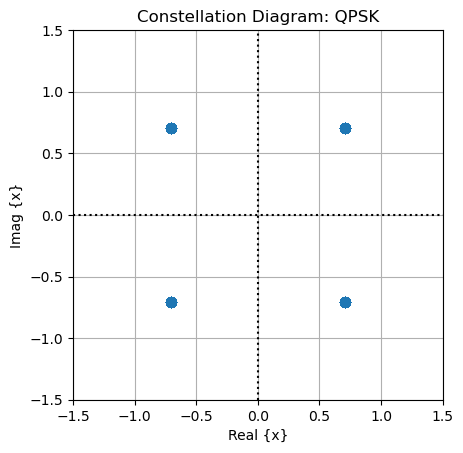
6. SSB Generation
[7]:
## Generate SSB Object
ssbObject = SSB_Grid(N_ID, True)
ssb = ssbObject(pssSequence, sssSequence, dmrsSequence, pbchSymbols)
# Loading SSB to Resource Grid
#####################################
# ssbPositionInBurst = np.ones(nssbCandidatesInHrf, dtype=int)
ssbPositionInBurst = np.zeros(nssbCandidatesInHrf, dtype=int)
ssbPositionInBurst[0] = 1
ssbRGobject = ResourceMapperSSB(ssbType=ssbType, carrierFrequency = center_frequency,
isPairedBand = isPairedBand,
withSharedSpectrumChannelAccess = withSharedSpectrumChannelAccess)
ssbGrid = ssbRGobject(ssb[0], ssbPositionInBurst, offsetInSubcarriers = 0,
offsetInRBs = 0, numRBs = nRB)[0:14]
fig, ax = ssbObject.displayGrid(option=1)
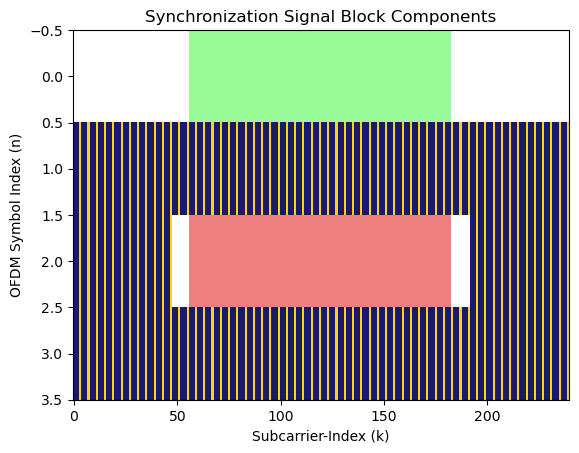
6. OFDM Implementation– Transmission of SSB.
[8]:
## Loading SSB to Resource Grid
numofGuardCarriers = (int((fftsize - Neff)/2), int((fftsize - Neff)/2))
offsetToPointA = 0
firstSCIndex = int(numofGuardCarriers[0] + offsetToPointA)
X = np.zeros((numOFDMSymbols, fftsize), dtype= np.complex64) # Generating grid of size 14 X FFT_Size.
X[:, firstSCIndex:firstSCIndex+ssbGrid.shape[-1]] = ssbGrid # Loading SSB into grid.
### OFDM Modulation at Transmitter
modulator = OFDMModulator(lengthCP[1]) # OFDM modulation
x_time = modulator(X).flatten() # Time domain samples from OFDM modulation.
### Plot Resource Grid
fig, ax = plt.subplots()
plt.imshow(np.abs(X), cmap = 'hot', interpolation='nearest', aspect = "auto")
ax = plt.gca();
ax.grid(color='c', linestyle='-', linewidth=1)
ax.set_xlabel("Subcarrier-Index (k)")
ax.set_ylabel("OFDM Symbol Index (n)")
ax.set_title("Heat map of Transmit Grid")
plt.show()
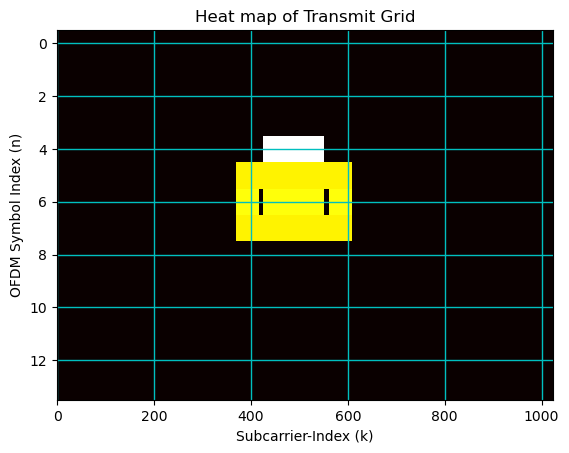
6. SDR Setup
[9]:
# SDR setup
sdr = adi.Pluto("ip:192.168.2.1") # Create object of SDR setup object and configure the IP of SDR connect to the system
sdr.sample_rate = int(sample_rate) # Sets the sample rate for the ADC/DAC of the SDR.
# Config Tx
sdr.tx_rf_bandwidth = int(sample_rate) # Set the bandwidth of the transmit filter | Can be set same as the sample rate
# For Pluto SDR, tx_rf_bandwidth should be between 200 kHz and 56 MHz.
sdr.tx_lo = int(center_frequency) # Sets the transmitter local oscillator frequency. The carrier is used to modulate/up-convert the analog information signal.
# For Pluto SDR, tx_lo can take a value between 325 MHz to 3.8 GHz.
sdr.tx_hardwaregain_chan0 = 0 # Sets the gain (dB) of the transmitter power amplifier. The higher the value the more the power radiated by antenna.
# For Pluto SDR, tx_hardwaregain_chan0 can take values between -90 to 0.
# Config Rx
sdr.rx_lo = int(center_frequency) # Sets the receiver local oscillator frequency.
# For Pluto SDR, rx_lo can take a value between 325 MHz to 3.8 GHz.
sdr.rx_rf_bandwidth = int(60*10**6) # Set the bandwidth (in Hz) of the reception filter
# For Pluto SDR, tx_rf_bandwidth should be between 200 kHz and 56 MHz.
sdr.rx_buffer_size = int(buffer_size) # Number of samples to read and load into SDR buffer.
# The upper limit on the size of this buffer is defined by the DRAM size.
sdr.gain_control_mode_chan0 = 'manual' # Defines the mode of receiver AGC.
# # AGC modes:
# # 1. "manual"
# # 2. "slow_attack"
# # 3. "fast_attack"
# The receive gain on the Pluto has a range from 0 to 74.5 dB.
sdr.rx_hardwaregain_chan0 = 40.0 # dB, increase to increase the receive gain, but be careful not to saturate the ADC
# Sets the amplification gain (dB) provided by the low noise amplifier (LNA).
# Relevant only when `gain_control_mode_chan0` is "manual".
6. Transmission
[10]:
# Start the transmitter
sdr.tx_cyclic_buffer = True # Enable cyclic buffers
sdr.tx(1.4*2**17*(x_time.repeat(1))) # start transmitting
6. Receive Samples from SDR
[11]:
# Clear buffer just to be safe
for i in range (0, 10):
raw_data = sdr.rx()
# Receive samples
rx_samples = sdr.rx()
6. Time Synchronization: Coarse Tuning
[12]:
## PSS Detection: Based on time domain PSS Correlation
numofGuardCarriers = (int((tfParams.fftsize - Neff)/2), int((tfParams.fftsize + Neff)/2))
offsetToPointA = 0
firstSCIndex = int(numofGuardCarriers[0] + offsetToPointA)
## PSS Detection: Based on time domain PSS Correlation
# pssDetection = PSSDetection("correlation", "threshold")
pssDetection = PSSDetection("largestPeak")
ssboffset = int(numofGuardCarriers[0]+offsetToPointA)
pssPeakIndices, pssCorrelation, rN_ID2, freqOffset = pssDetection(rx_samples, fftSize, lengthCP = lengthCP[1],
nID2 = None, freqOffset = ssboffset)
## PSS Detection Plot
#################################################################
scaleFig = 1.75
fig, ax = plt.subplots(figsize=(30/scaleFig, 15/scaleFig))
# single line
ax.plot(pssCorrelation)
ax.vlines(x = pssPeakIndices, ymin = 0*pssCorrelation[pssPeakIndices],
ymax = pssCorrelation[pssPeakIndices], colors = 'purple')
ax.set_ylim([0,np.max(pssCorrelation)*1.1])
ax.set_xlabel("Time Samples Index")
ax.set_ylabel("Amplitude of Time Domain Correlation")
ax.set_title("Amplitude (of Time Domain Correlation) vs Time-samples")
plt.show()
**(rasterOffset, PSS-ID) (368, 0)
**(rasterOffset, PSS-ID) (368, 1)
**(rasterOffset, PSS-ID) (368, 2)
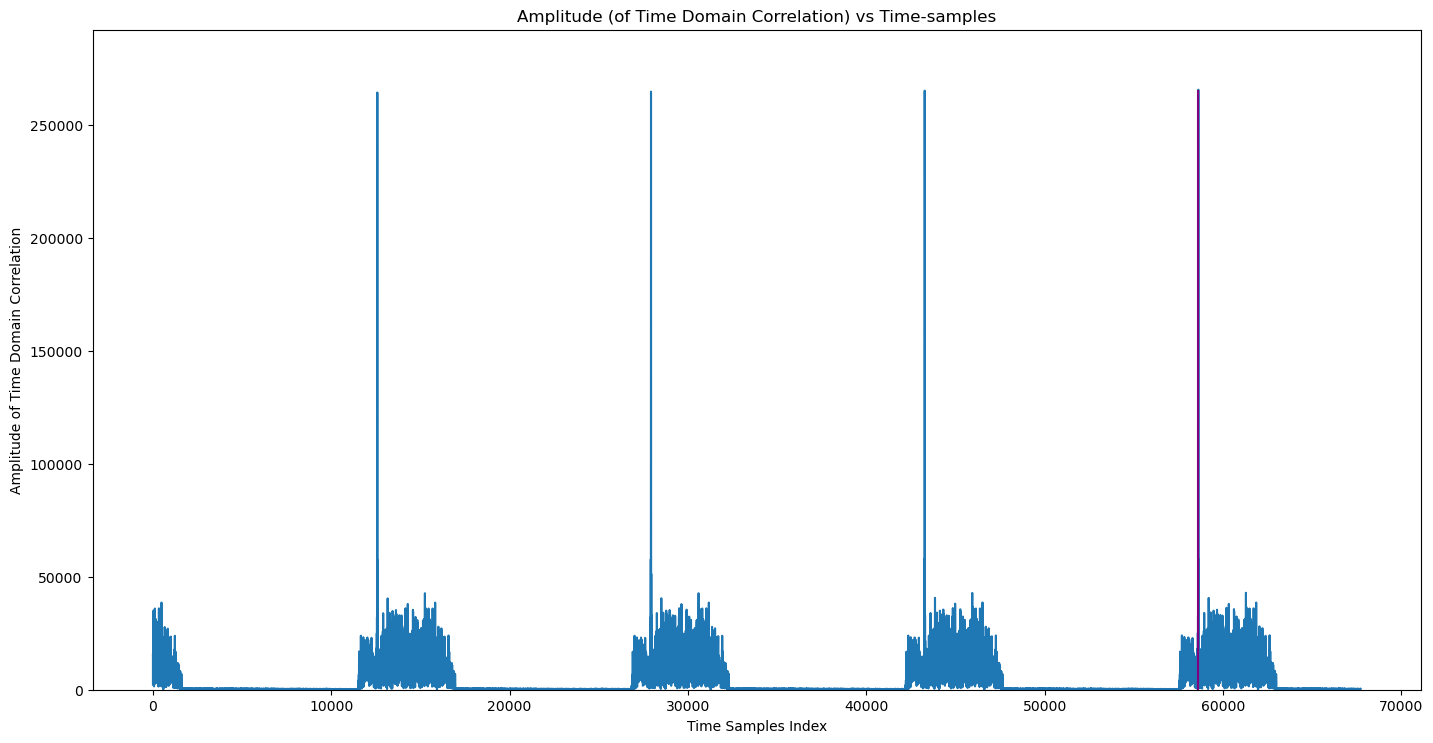
6. CFO Estimation
[13]:
## Parameters for computing CFO
cyclic_prefix_length = lengthCP[1] # Length of cyclic prefix
numSamples = fftSize + cyclic_prefix_length # OFDM samples of 1 symbol
firstIndex = pssPeakIndices # PSS detection
pssOfdmSymbols = rx_samples[firstIndex: firstIndex + numSamples] # PSS samples
obj = CarrierFrequencyOffsetEstimation(fftSize,cyclic_prefix_length)
cfoEst = obj(pssOfdmSymbols,numCFOIteration = 2) # Computed CFO
6. OFDM Demodulation
[14]:
## OFDM Demodulator Object
ofdmDemodulator = OFDMDemodulator(fftSize, lengthCP[1])
pssStartIndex = pssPeakIndices
indices = np.arange(rx_samples.size)
# With CFO correction
cfo = cfoEst
rxGrid = ofdmDemodulator(((np.exp(-1j*cfo*indices/fftSize)*rx_samples).reshape(1,-1))[...,pssStartIndex:(pssStartIndex+4*(fftSize+lengthCP[1]))])
ssbEstimate = rxGrid[:,:,ssboffset:(ssboffset+240)]
# Plot Received Resource Grid
fig, ax = plt.subplots()
plt.imshow(np.abs(rxGrid[0]), cmap = 'hot', interpolation='nearest', aspect = "auto")
ax = plt.gca();
ax.grid(color='c', linestyle='-', linewidth=1)
plt.show()
print("The Estimated CFO is " +str(cfo))
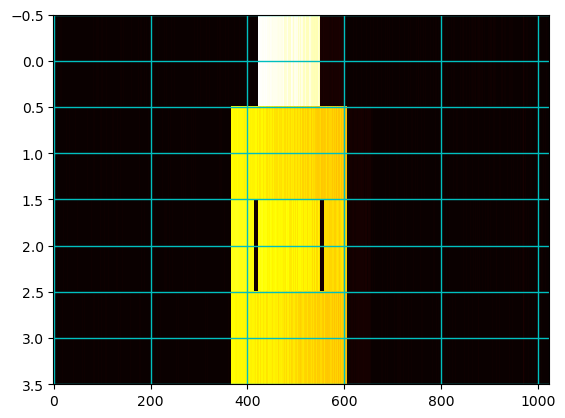
The Estimated CFO is 0.004330489340292081
6. Extract SSB Grid
[15]:
## Plot SSB
fig, ax = plt.subplots()
ax.imshow(np.abs(ssbEstimate[0]), cmap = 'hot', interpolation='nearest', aspect = "auto")
ax.grid(color='c', linestyle='-', linewidth=1)
ax.set_xlabel("Subcarrier-Index (k)")
ax.set_ylabel("Normalized Magnitude")
ax.set_title("Heat-map of Received SSB Grid")
plt.show()
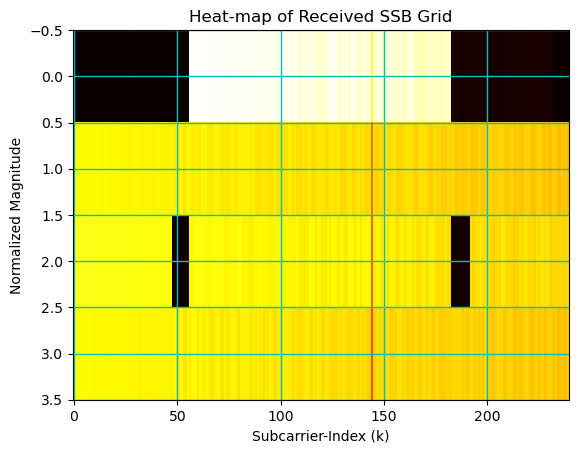
6. SSS and DMRS Parameter Detection
SSS Detection
PBCH Parameter Estimation
[16]:
## N_ID_1 Estimation: SSS based
sssDetection = SSSDetection(method="channelAssisted", nID2=rN_ID2)
rN_ID1 = sssDetection(ssbEstimate[0])
rN_ID = 3*rN_ID1 + rN_ID2 # Estimating Physical cell-ID.
## Generate SSB object to get DMRS and PBCH Indices
rxSSBobject = SSB_Grid(rN_ID)
rxDMRSIndices = rxSSBobject.dmrsIndices # Indices of PBCH DMRS.
## Generate DMRS sequence
nssbCandidatesInHrf = 4
dmrsLen = 144 # Length of DMRS sequence
dmrsDetection = DMRSParameterDetection(int(rN_ID), nssbCandidatesInHrf)
rssbIndex, rHrfBit = dmrsDetection(ssbEstimate[0])
rxDMRSobject = DMRS("PBCH", int(rN_ID), int(rssbIndex), nssbCandidatesInHrf, rHrfBit)
rxDMRSseq = rxDMRSobject(dmrsLen) # DMRS sequence.
6. Channel Estimation and PBCH Symbol Equalization
PBCH supports following: - Channel Estimation schemes: - Zero-forcing: “ZF” - Minimum mean sequare estimation: “MMSE” - Channel interpolation schemes: - Nearest neighbour: “NN” - Linear: “Linear” - Spline: “Spline” of any order (3,5,7,9,……)
[17]:
# ## Estimating the channel at DMRS (t-f) location, interpolting for data (t-f) location and equalizing the symbols
# ## Object for Channel Estimation
chanEst = ChannelEstimationAndEqualizationPBCH(estimatorType = "ZF", interpolatorType = "Linear", isUEmobile=True)
pbchEstimate = chanEst(ssbEstimate[0], rxDMRSseq, rN_ID)
## Plot SSB
fig, ax = plt.subplots()
ax.imshow(np.abs(chanEst.channelEstimates[0]), cmap = 'hot', interpolation='nearest', aspect = "auto")
ax.grid(color='c', linestyle='-', linewidth=1)
ax.set_xlabel("Subcarrier-Index (k)")
ax.set_ylabel("Normalized Magnitude")
ax.set_title("Heat-map of Received SSB Grid")
plt.show()
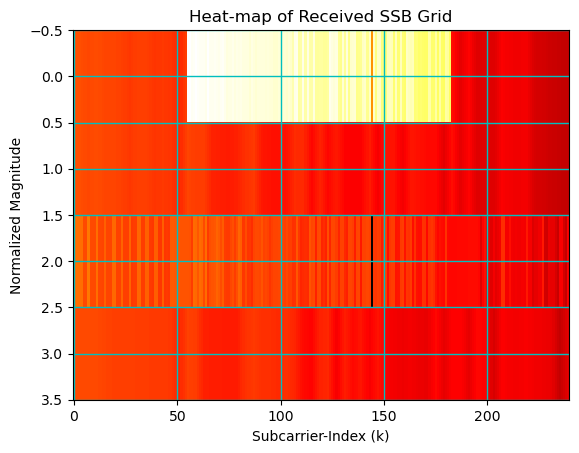
[18]:
chanEst.channelEstimates[0].shape
[18]:
(4, 240)
6. PBCH Decoding
[19]:
## PBCH Chain for Decoding information
polarDecoder = "SCL"
symbolDemapper = "app"
extractMIBinfo = True
pbchDecoder = PBCHDecoder(center_frequency, int(rN_ID), nssbCandidatesInHrf,
rssbIndex, polarDecoder, symbolDemapper)
rxMIB, check = pbchDecoder(pbchEstimate, 10, extractMIBinfo)
<frozen toolkit5G.ChannelCoder.PolarCoder.polarDecoder>:494: UserWarning: Required ressource allocation is large for the selected blocklength. Consider option `cpu_only=True`.
6. Constellation Diagram: UE
[20]:
qpsk = np.array([1+1j, 1-1j, -1+1j, -1-1j])/np.sqrt(2)
fig, ax = plt.subplots()
ax.set_aspect(True)
ax.scatter(np.real(pbchEstimate), np.imag(pbchEstimate))
ax.scatter(np.real(qpsk), np.imag(qpsk), )
ax.grid()
ax.axhline(y=0, ls=":", c="k")
ax.axvline(x=0, ls=":", c="k")
ax.set_xlim([-1.5, 1.5])
ax.set_ylim([-1.5, 1.5])
ax.set_xlabel("Real {x}")
ax.set_ylabel("Imag {x}")
ax.set_title("Constellation Diagram: QPSK")
plt.show()
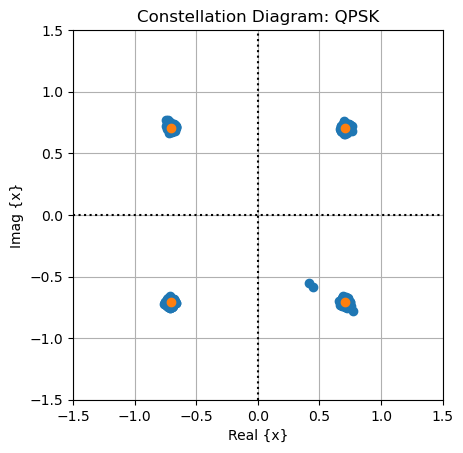
6. Checking whether CRC is correct
[21]:
check
[21]:
array([[ True]])
6. Quasi-realtime: CFO Estimation and Reconstruction
Note: The following snippet of code only works with interactive maplotlib.
 Please ensure that you have intractive matplotlib installed on your system.
Please ensure that you have intractive matplotlib installed on your system.uncomment the ``%matplotlib widget`` in first code block for the following section of code to work
[22]:
# function that draws each frame of the animation
def animate(i):
# Receive samples
rx_samples = sdr.rx()
pssPeakIndices, pssCorrelation, rN_ID2, freqOffset = pssDetection(rx_samples, fftSize, lengthCP = lengthCP[1],
nID2=None, freqOffset = ssboffset)
if(pssPeakIndices < 3*(fftSize + lengthCP[1])):
pssPeakIndices = pssPeakIndices + 14*(fftSize + lengthCP[1])
elif(pssPeakIndices > rx_samples.size - 13*(fftSize + lengthCP[1])):
pssPeakIndices = pssPeakIndices - 14*(fftSize + lengthCP[1])
# CFO estimation
obj = CarrierFrequencyOffsetEstimation(fftSize,lengthCP[1])
cfoEst = obj(rx_samples[pssPeakIndices: pssPeakIndices + numSamples],numCFOIteration = 2) # Computed CFO
## OFDM Demodulator Object
ofdmDemodulator = OFDMDemodulator(fftSize, lengthCP[1])
pssStartIndex = pssPeakIndices
# With CFO correction
cfo = cfoEst
rxGrid = ofdmDemodulator(((np.exp(-1j*cfoEst*indices/fftSize)*rx_samples).reshape(1,-1))[...,pssStartIndex:(pssStartIndex+4*(fftSize+lengthCP[1]))])
ssbEstimate = rxGrid[:,:,ssboffset:(ssboffset+240)]
chanEst = ChannelEstimationAndEqualizationPBCH(estimatorType = "ZF", interpolatorType = "NN", isUEmobile=True)
pbchEstimate = chanEst(ssbEstimate, rxDMRSseq, rN_ID)
## PBCH Chain for Decoding information
# carrierFreq, cellID, nssbCandidatesInHrf, ssbIndex, polarDecType, symbolDemapperType
pbchDecoder = PBCHDecoder(center_frequency, int(rN_ID), nssbCandidatesInHrf, rssbIndex, polarDecoder, symbolDemapper)
rxMIB, check = pbchDecoder(pbchEstimate, 10, extractMIBinfo)
ax[0].clear()
ax[0].set_xlim([-1.5, 1.5])
ax[0].set_ylim([-1.5, 1.5])
ax[0].scatter(np.real(pbchEstimate), np.imag(pbchEstimate))
ax[0].scatter(np.real(qpsk), np.imag(qpsk), )
ax[0].grid()
ax[0].axhline(y=0, ls=":", c="k")
ax[0].axvline(x=0, ls=":", c="k")
ax[0].set_xlabel("Real {x}")
ax[0].set_ylabel("Imag {x}")
ax[0].set_title("Constellation Diagram | NN")
chanEst = ChannelEstimationAndEqualizationPBCH(estimatorType = "ZF", interpolatorType = "Linear", isUEmobile=True)
pbchEstimate = chanEst(ssbEstimate, rxDMRSseq, rN_ID)
## PBCH Chain for Decoding information
# carrierFreq, cellID, nssbCandidatesInHrf, ssbIndex, polarDecType, symbolDemapperType
pbchDecoder = PBCHDecoder(center_frequency, int(rN_ID), nssbCandidatesInHrf, rssbIndex, polarDecoder, symbolDemapper)
rxMIB, check = pbchDecoder(pbchEstimate, 10, extractMIBinfo)
ax[1].clear()
ax[1].set_xlim([-1.5, 1.5])
ax[1].set_ylim([-1.5, 1.5])
ax[1].scatter(np.real(pbchEstimate), np.imag(pbchEstimate))
ax[1].scatter(np.real(qpsk), np.imag(qpsk), )
ax[1].grid()
ax[1].axhline(y=0, ls=":", c="k")
ax[1].axvline(x=0, ls=":", c="k")
ax[1].set_xlabel("Real {x}")
ax[1].set_ylabel("Imag {x}")
ax[1].set_title("Constellation Diagram | Linear")
chanEst = ChannelEstimationAndEqualizationPBCH(estimatorType = "ZF", interpolatorType = "Spline", isUEmobile=True)
pbchEstimate = chanEst(ssbEstimate, rxDMRSseq, rN_ID)
## PBCH Chain for Decoding information
# carrierFreq, cellID, nssbCandidatesInHrf, ssbIndex, polarDecType, symbolDemapperType
pbchDecoder = PBCHDecoder(center_frequency, int(rN_ID), nssbCandidatesInHrf, rssbIndex, polarDecoder, symbolDemapper)
rxMIB, check = pbchDecoder(pbchEstimate, 10, extractMIBinfo)
ax[2].clear()
ax[2].set_xlim([-1.5, 1.5])
ax[2].set_ylim([-1.5, 1.5])
ax[2].scatter(np.real(pbchEstimate), np.imag(pbchEstimate))
ax[2].scatter(np.real(qpsk), np.imag(qpsk), )
ax[2].grid()
ax[2].axhline(y=0, ls=":", c="k")
ax[2].axvline(x=0, ls=":", c="k")
ax[2].set_xlabel("Real {x}")
ax[2].set_ylabel("Imag {x}")
ax[2].set_title("Constellation Diagram | Spline")
# Plot SSB
fig, ax = plt.subplots(1,3, figsize = (10,3))
ax[0].set_aspect(True)
ax[1].set_aspect(True)
ax[2].set_aspect(True)
scale = 100
#####################
# run the animation
#####################
# frames= 20 means 20 times the animation function is called.
# interval=500 means 500 milliseconds between each frame.
# repeat=False means that after all the frames are drawn, the animation will not repeat.
# Note: plt.show() line is always called after the FuncAnimation line.
anim = animation.FuncAnimation(fig, animate, frames=1000, interval=1, repeat=False, blit=True)
# saving to mp4 using ffmpeg writer
plt.show()
anim.save("Channel_Estimation_RT.gif", fps = 10)
# writervideo = animation.FFMpegWriter(fps=60)
# anim.save('Overall.mp4', writer=writervideo)

[ ]: